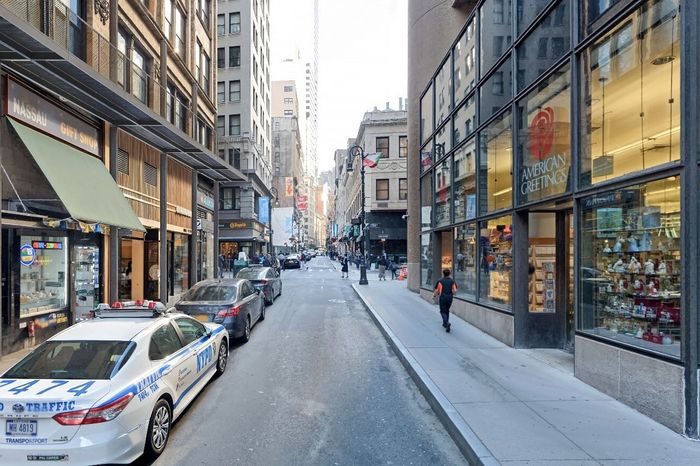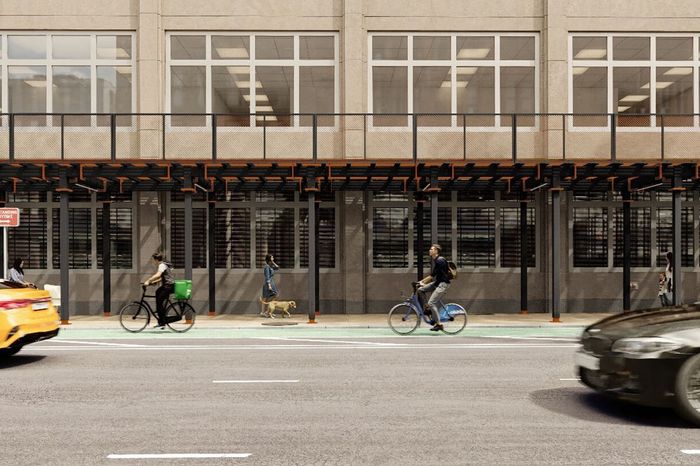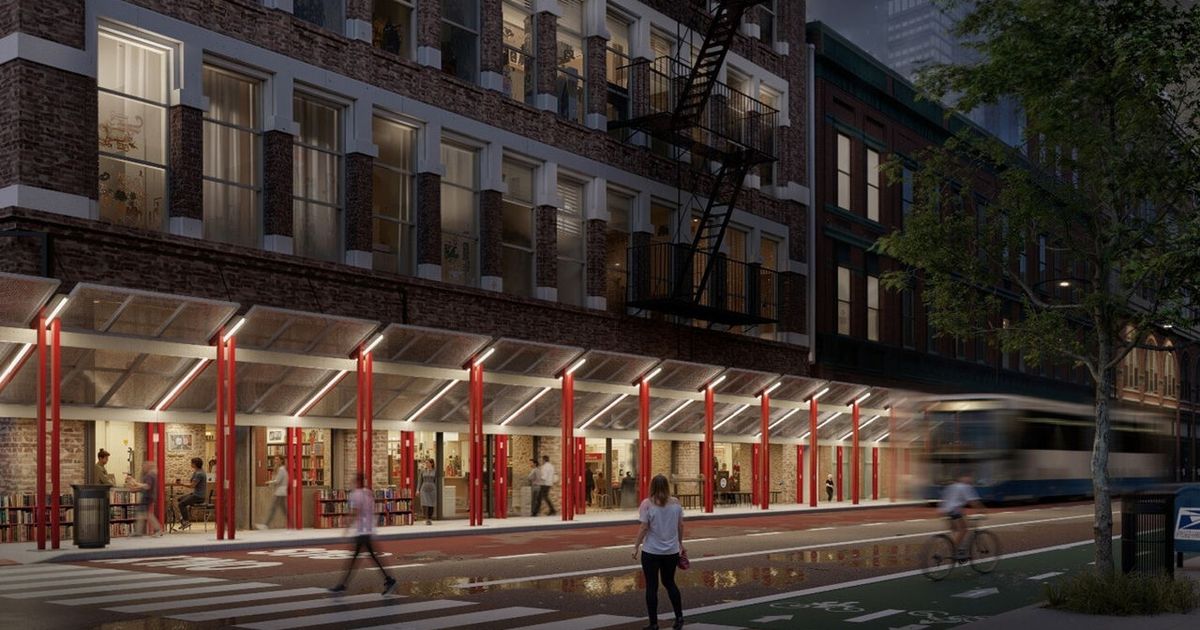
PAU’s “Speed Shed,” one of six designs approved by New York City in its sidewalk-shed glow-up program. This one uses netting instead of a hard roof and is intended mostly for temporary façade work and emergencies.
Photo: PAU/Office of the Mayor
En route to my desk to write this column, I passed the office tower at 3 Park Avenue. It’s a big caramel-colored prism at the corner of 34th Street, built in 1973. The plaza out front has spent about 13 of those years — a quarter of its entire existence — wrapped in a plywood construction shed, first put up in 2012 and periodically reshuffled, at one point briefly receding from the sidewalk and then re-expanding. (The city’s permit map says it dates only to June 2021, but a decade-plus of Google Street View tells the full tale.) The sidewalk tunnel around the building all but obliterated access to a Le Pain Quotidien café on the lobby level — truly, you would have had no idea it was there but for a small temporary sign — and it may not be a coincidence that the LPQ closed around 2019 and its space remains untenanted. The base of the tower also incorporates the former Norman Thomas High School, now home to a couple of smaller DOE schools and one charter Success Academy. The entry to the school, never especially inviting, now looks like a particularly grim garage. The sidewalk shed is nearly the same age as the ninth-graders walking beneath it.
Judge the Eric Adams mayoralty as you will — as the voters already have — but on this subject, it’s done some good and popular governing. The administration’s Get Sheds Down program intends to be comprehensive, calling in part for new designs that are less oppressive to walk around or under, along with a variety of other procedural and policy reforms. (By the way, “scaffolding” is what most people outside the industry call these structures, but that’s the stuff that climbs the walls, not the stuff over the pavement. “Sidewalk shed” or “sidewalk bridge” describes the thing we’re talking about.) It shouldn’t have taken decades of nearly universal disdain for the city to address such a festering and wildly unpopular situation, but better late than never.
This week we got a look at the six new designs that have been okayed by the city, which should be potted into the building code early next year and go into production soon, or soonish, thereafter. They are inventive solutions, which is not a surprise; this is a classic design-school-charette assignment, the kind of public-realm conundrum that designers love to think through. The final schemes are principally the work of two firms, Arup (the large British architecture firm whose most visible works in New York are Little Island and the stations of the Second Avenue Subway) and PAU (whose founder, Vishaan Chakrabarti, pops up in virtually every public-space discussion these days, especially when it comes to Penn Station). They’re working with an array of partners from the architecture and engineering realm, turning sketches and renderings into specifications and, eventually, a pile of components that can be piled on a flatbed truck and bolted together on a sidewalk.

Arup’s “Flex Shed,” another light-duty option intended for smaller projects, like façade work on the brownstones in the rendering.
Photo: Arup/Office of the Mayor

Arup’s “Air Shed” is attached to the building, with no supports down at the street level.
Photo: Arup/Office of the Mayor
The long-standing city-approved design, the one we’ve had for years, will likely be around indefinitely because it’s cheap and tough. The system of steel-pipe uprights and cross braces, corrugated roof, plywood panels painted dark green, and little plywood foot shims to keep it all level is certainly sturdy, at least most of the time. In many cases, it’s also dank, close, and unpleasant. It’s seen minor improvements over the years — LEDs have lately replaced the dim incandescents that used to illuminate the covered sidewalk — and they’ve helped a little. A bit over a decade ago, in a much bigger step up, an alternative began to appear on our streets, produced by a company called Urban Umbrella. It raised the roof, opened up the space between the uprights, and is far brighter and airier underneath. But it’s hardly a broad replacement. According to the New York Times, it’s in use at 105 out of 8,438 sites, and it costs roughly twice as much as the basic version. It’s unstated where these newer offerings will fall on the price scale, but some look to be cheaper to construct than others, and the final costs are likely to mirror that.
The biggest thing the new designs do is minimize the external framing — that is, they open up the curb side of the shed, much as the Urban Umbrella design did, removing the crosshatched pipes that block pedestrian access. That’s important, whether for vehicles dropping people off, or for restaurateurs trying to make a living, or for you if you simply want to step out into your own damn street. The six options have been fitted to a range of use cases: One style, for example, is of very light gauge, with netting instead of a hard roof, and it’s meant to be used in (among other situations) an emergency — a façade loses a brick, say, and the owners need to put something up immediately while it awaits inspection. Others, like the one called the “Rigid Shed,” are intended for major projects and sturdy enough to catch a dropped pallet of construction supplies. Still another has no street-level supports at all — it’s bolted to the building, more like an awning than a separate structure. (My colleague Justin Davidson’s superb story about perfecting the New York street included something very similar.) Several of the designs incorporate a roof that slopes up and out, which lets more light through to the sidewalk below and will likely eliminate the curbside waterfall when it’s raining. The aesthetic trade-offs, of protection and durability in exchange for blockiness, are obvious: The lightest-duty structures, intended for briefer use under less demanding conditions than their chunkier counterparts, will clearly be the least visually intrusive. Even the heavy-duty ones, though, are a lot more porous than most of what we see now.

Arup’s heavy-duty “Rigid Shed” for major construction zones.
Photo: Arup/Office of the Mayor

PAU’s “Baseline Shed,” to be available in heavy- and light-duty versions. The roof is transparent.
Photo: PAU/Office of the Mayor

PAU’s “Wide Baseline Shed,” with fewer columns, intended for projects on major streets with wide and heavily used sidewalks.
Photo: PAU/Office of the Mayor
All to the good. Nonetheless, even ideal sidewalk sheds are still sidewalk sheds, and they will still get dirty, gather windswept trash, wreck the sidewalk-café business, and grow shabby and promo-stickered over time. The real power in the Get Sheds Down proposal — the firmly crossbraced steel pipe holding it up, if you like — is the financial one, and next year we’ll see just how sturdy a set of supports it is. If a building owner keeps a shed up for years, which typically happens when that owner is deferring repairs, the Adams plan begins to impose fines. The longer the shed stays up, the more those fines escalate. Keep the thing in place for well past its limit, and, based on its size and age, the penalty can eventually hit $6,000 a month. New permits will be of shorter duration than they have been, and renewals will be handed out more stingily.
All of those incentives were signed into law this spring, and the rules don’t take effect until January. In the meantime, a Department of Buildings representative tells me, a program that goes after sheds that have long overstayed their welcome has gotten 429 removed so far. That’s a modest dent in a big problem, but the DoB says the total number of sheds citywide is down about 10 percent since 2023. Enforcement will, naturally, be the key to carrying off real change, and we’ll see by next summer just how much of it the agency can handle. It will come too late for that Le Pain Quotidien at 3 Park Avenue, but maybe the Success Academy kids will be able to take their graduation photos on the plaza out front. In the sun.
Sign Up for the Curbed Newsletter
A daily mix of stories about cities, city life, and our always evolving neighborhoods and skylines.
Vox Media, LLC Terms and Privacy Notice
Related
